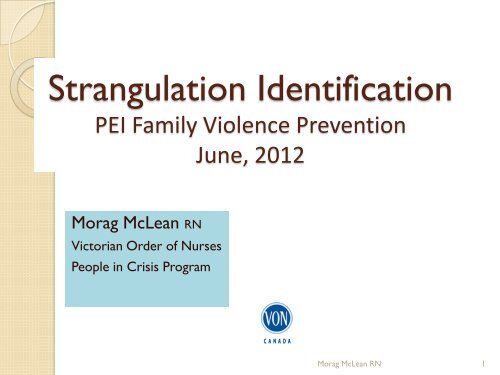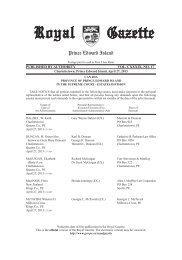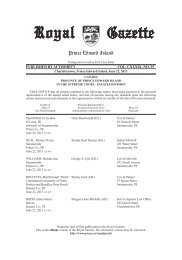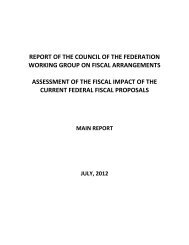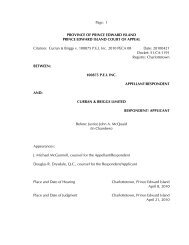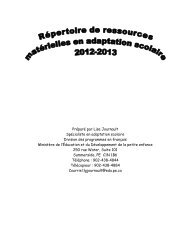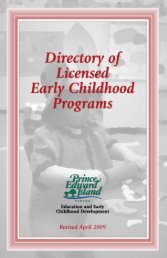Strangulation Identification
Strangulation Identification
Strangulation Identification
You also want an ePaper? Increase the reach of your titles
YUMPU automatically turns print PDFs into web optimized ePapers that Google loves.
<strong>Strangulation</strong> <strong>Identification</strong><br />
PEI Family Violence Prevention<br />
June, 2012<br />
Morag McLean RN<br />
Victorian Order of Nurses<br />
People in Crisis Program<br />
Morag McLean RN<br />
1
Overview<br />
• Family Violence Hurts Everyone…how FV impacts the health of<br />
the individual, family and community<br />
• Definition and prevalence of strangulation in FV<br />
• Signs and symptoms of strangulation<br />
• How to identify a victim of strangulation<br />
• Why it is important to identify a victim<br />
• The impact of strangulation – Children who witness<br />
• The benefits of having trained front line workers<br />
Morag McLean RN<br />
2
VON Canada Edmonton Branch<br />
PEOPLE IN CRISIS PROGRAM<br />
“TRUST IS THE KEY”<br />
• Established in 1979 when the first women’s shelter<br />
opened in Edmonton<br />
• RN’s provide client centered primary health care<br />
• Five first stage and one second stage women’s<br />
shelters, Elder Abuse Intervention Team, Seniors Safe<br />
House<br />
• Inter-professional collaboration with community and<br />
government agencies.<br />
Morag McLean RN 3
How much do you know about<br />
Family Violence?<br />
Morag McLean RN 4
The Myths and Facts of Family Violence<br />
1. All FV is physical<br />
◦ FV includes various forms of abuse, violence,<br />
mistreatment and neglect, it can be:<br />
• Physical<br />
• Emotional and psychological<br />
• Spiritual<br />
• Financial<br />
• Sexual<br />
• Medication<br />
There is rarely only one form of abuse in a<br />
relationship<br />
Morag McLean RN 5
The Myths and Facts of Family Violence<br />
2. Women are the only victims of FV<br />
◦ Women are abused in much higher numbers<br />
than men<br />
• Men are abused by men and women<br />
• Women are abused by men and women<br />
• Women and men are abused by adult children of<br />
both genders<br />
• Children are abused by men and women<br />
• Children are traumatized when they witness abuse<br />
Morag McLean RN 6
The Myths and Facts of Family Violence<br />
3. FV occurs only in poor, uneducated or<br />
immigrant families. Family violence is<br />
“cultural”<br />
• FV occurs among all types of families, regardless of<br />
income, profession, region, ethnicity, educational<br />
level or race<br />
• The rate of reported family violence in new<br />
Canadians is lower than established Canadians<br />
(Stats Canada 1999)<br />
◦ Study done in English and French and not representative<br />
of immigrant women (Canadian Council on Social Development, 2004)<br />
Morag McLean RN 7
The Myths and Facts of Family Violence<br />
3 (cont.). FV occurs only in poor, uneducated or immigrant<br />
families. Family violence is “cultural”<br />
• Barriers to accessing resources include:<br />
◦ Language issues [1]<br />
• Isolation<br />
◦ Lack of economic support [1]<br />
• Limited knowledge of community supports (Raj &Silverman, 2002; Health Canada,1993; Smith, 2004)<br />
• Less likely to access social support than established Canadians (Hyman et al., 2006)<br />
◦ Suspicion of state intervention [1]<br />
◦ Fear of discrimination and racism [1]<br />
◦ Loss of social support [1]<br />
◦ Loss of cultural community [1]<br />
◦ Lack of culturally appropriate services<br />
◦ Fear of losing sponsorship and subsequent of deportation<br />
• Fear abuser will be deported [1]<br />
◦ Fear of losing children [1]<br />
[1] Robin Mason, Women’s College Research Institute & University of Toronto; “What we know about IPV in the lives of<br />
immigrant women in Canada”<br />
Morag McLean RN 8
The Myths and Facts of Family Violence<br />
4. Women with disabilities are abused at the same<br />
rate as non-disabled women<br />
• Estimated that women with disabilities are 1.5 to 10 times more<br />
likely to be abused<br />
• Barriers include:<br />
◦ Societal attitudes towards persons with disabilities<br />
• Treated like children<br />
• Trained to be compliant and are punished for assertiveness<br />
• When they report are not believed<br />
◦ Dependence and enmeshment with caregiver<br />
◦ Dependence on a larger group of care providers<br />
◦ Isolation<br />
◦ Fear of institutionalization<br />
◦ Fear of loss of children<br />
◦ Lack of access to information on support services for victims of FV<br />
◦ Lack of access to communication devices for deaf<br />
◦ Lack of accessible shelters<br />
◦ Lack of accessible transportation<br />
Public Health Agency of Canada, “Family Violence Against Women with Disabilities”<br />
Morag McLean RN 9
The Myths and Facts of Family Violence<br />
5. Alcohol and drugs cause abuse<br />
◦ There is a high correlation between alcohol, and drug<br />
abuse<br />
◦ Abusers will use drinking and sunstance use as an<br />
excuse for violence<br />
◦ Victims will use abusers drinking and drug use to<br />
excuse and explain the behaviours<br />
◦ Stopping the abusers' drinking will not stop the<br />
violence.<br />
Morag McLean RN 10
Definition of Family Violence<br />
a systemic pattern of abusive behaviours<br />
where the relationship is characterized by<br />
intimacy, dependency or trust<br />
the abusive behaviours are used to gain<br />
power, control and induce fear<br />
Community Initiative Against Family Violence, Edmonton, AB (CIAFV)<br />
Morag McLean RN 11
The Cycle of Violence<br />
dvsolutions.org<br />
Morag McLean RN<br />
12
Impact of Abuse on the Community<br />
• Increased poverty for victims<br />
◦ Access to affordable acceptable housing<br />
◦ Poor nutrition<br />
*Pre-term births<br />
*Failure to thrive<br />
• Decreased work place/school productivity and<br />
safety for victim and their co-workers<br />
◦ Poor performance and achievement. Lost work days<br />
◦ Safety issues for co-workers<br />
• Increased economic burden on the community<br />
◦ Social agencies and programming<br />
*Income support<br />
*Addictions support<br />
*Children and Family Services<br />
*Counselling services<br />
◦ Hospital and Emergency Room visits and admissions<br />
*Addictions *Injuries *Miscarriages *Chronic disease<br />
Morag McLean RN 13
Societal Normalization/Desensitization<br />
What do you see?<br />
Morag McLean RN<br />
14
Types of Abuse<br />
Morag McLean RN 15
Emotional or Psychological Abuse<br />
• Yelling, screaming, name calling, insults, threats,<br />
humiliation, or criticism, excessive jealousy or<br />
suspiciousness, threatening or harassing, isolation, depriving<br />
of love<br />
• Stalking, destruction of property<br />
• Has a high likelihood of escalation to physical abuse<br />
• The effects of emotional abuse may be worse than the<br />
consequences of physical abuse<br />
Stalking and wilful destruction of another persons property<br />
are against the law<br />
Morag McLean RN 16
Sexual Abuse<br />
• Sexual assault (rape), unwanted sexual touching, sexual<br />
harassment, marital rape<br />
• Human trafficking, sexual exploitation, or forcing someone<br />
to participate in unwanted, unsafe, degrading, or offensive<br />
sexual activity<br />
• Controlling a woman’s reproductive choices<br />
• Female genital mutilation<br />
Sexual assault and sexual exploitation are against the law<br />
Morag McLean RN 17
Economic or Financial Abuse<br />
Control of:<br />
achieving or maintaining financial<br />
independence working (or not)<br />
occupational choices<br />
access to financial resources<br />
depleting financial resources<br />
Failing to provide the necessities of life to a<br />
spouse or dependent is against the law<br />
Morag McLean RN 18
Spiritual Abuse<br />
• Control of participation in spiritual or religious<br />
practices<br />
• Isolation from community of belief<br />
• Ridicule of belief<br />
• Use of spiritual belief and religious text to justify<br />
control<br />
• Co-Abuse – by other wives or in-laws<br />
• Threats to share “damning” information<br />
Morag McLean RN 19
A Relationship is Abusive if a Person:<br />
• Feels like they are always “walking on<br />
eggshells”<br />
• Dominates and controls the other<br />
• Keeps the other from seeing family and friends<br />
• Uses name-calling or putdowns<br />
• Damages the other’s property<br />
• Shows extreme jealousy or possessiveness<br />
• Pushes, hits or physically restrains the other<br />
• Forces sexual touching or sex<br />
Morag McLean RN 20
Who is at Risk of Being Abused?<br />
• Anyone of us may experience abuse during our<br />
lifetime<br />
• Increased risk<br />
– Female<br />
– Age (18 -24) [higher risk of being killed]<br />
– Age (65 or older)<br />
– Disabled<br />
– Aboriginal<br />
– Victimized as a child<br />
– Exposed to maternal violence<br />
– Pregnant<br />
Morag McLean RN 21
What do you Know About<br />
<strong>Strangulation</strong>? - Quiz<br />
Morag McLean RN<br />
22
Strangled or Choked?<br />
• Choked and strangled are used<br />
synonymously<br />
• Physiological differences<br />
• Legal importance in using “strangled”<br />
Morag McLean RN 23
STRANGULATION ….<br />
Is a high risk<br />
and potentially<br />
lethal event<br />
Morag McLean RN 24
“Unconscious within seconds<br />
Death within minutes….<br />
It’s not a slap on the face”<br />
“For some, choking was just another form of<br />
physical violence, like pushing…<br />
it was normal to be choked”<br />
McClane & Strack<br />
Morag McLean RN 25
<strong>Strangulation</strong>…<br />
Hanging<br />
Manual (Throttling)<br />
one hand<br />
two hands<br />
knee or foot<br />
Ligature (Garroting)<br />
Chokehold (Sleeper hold, carotid restraint) forearm<br />
Morag McLean RN 26
<strong>Strangulation</strong>….<br />
Danger Assessment survey 509 respondents<br />
entering nine Alberta women’s shelters<br />
• When asked over 55% disclosed they had been<br />
“choked”<br />
• 60% reported they believed the perpetrator was<br />
capable of killing them<br />
• If they tell you they thought they would die, believe<br />
them<br />
Dr. Jacquelyn Campbell, Danger Assessment<br />
Morag McLean RN 27
<strong>Strangulation</strong>…<br />
Survey results of women who have been strangled while in an abusive<br />
relationship.<br />
62 respondents in three California women’s shelters<br />
• 93% lived in the same house as the abuser<br />
• 78% strangled in their home<br />
• 70% believed they would die<br />
• 68% concurrent forms of abuse (verbal/physical)<br />
• *13% strangled AFTER EPO was granted<br />
• *9% abuser was friend, stranger, mother,<br />
grandmother<br />
Wilbur, L. et al<br />
Morag McLean RN 28
<strong>Strangulation</strong>…<br />
• May cause a variety of serious medical conditions with<br />
symptoms lasting for weeks after the event [1]<br />
• Greater risk associated with multiple events [1]<br />
• Relatively prevalent form of family violence [2]<br />
• Significant predictor for risk of future lethal violence [2]<br />
[1] McLane George E. [2] Glass, N. et al.<br />
Morag McLean RN 29
<strong>Strangulation</strong> ……<br />
• 99% of perpetrators are male [1]<br />
• 90% of cases have a history of DV [1]<br />
• In 70-80% of DV cases the victim will recant [2]<br />
• 50% of cases have children as witnesses [1]<br />
• 10% of violent deaths in US are due to strangulation<br />
(with six female victims to every male victim)<br />
• 3% will seek voluntary medical attention [1]<br />
[1]Crisis Connection. Non-lethal <strong>Strangulation</strong> www/crisisconnectioninc.org<br />
[2]Jacquelyn Campbell PhD, RN, John Hopkins School of Nursing<br />
Morag McLean RN<br />
30
<strong>Strangulation</strong>…<br />
Is misunderstood……………………<br />
Many front line workers, health care<br />
professionals, and police believe they know<br />
all the signs and symptoms of<br />
strangulation……….<br />
unfortunately they don’t!<br />
Morag McLean RN 31
<strong>Strangulation</strong> is Misunderstood…<br />
“BRENDA”<br />
• Police and EMS respond to “domestic”<br />
• Brenda assaulted with frying pan and broom<br />
handle<br />
• ER treated by physician and discharged<br />
• Shelter nursing assessment<br />
• Returned to ER for reassessment<br />
• Police, EMS and physician missed the<br />
strangulation<br />
Morag McLean RN 32
Blood and Nerve Supply to the<br />
Head and Neck<br />
The blood supply to and from the brain is crucial for brain function.<br />
The nerve supply to the head and neck controls functions such as:<br />
swallowing, speaking, breathing, blood pressure, heart rate, and bowel function.<br />
Morag McLean RN 33
The Physics of <strong>Strangulation</strong>…<br />
Quality of applied<br />
force<br />
+<br />
Duration of applied<br />
force<br />
+<br />
Surface area of<br />
applied force<br />
+<br />
Anatomy<br />
=<br />
Death in 4-5 minutes<br />
“...although<br />
mechanical airway<br />
compromise occurs<br />
and ultimately<br />
compromises<br />
patient management,<br />
it (airway<br />
compromise)<br />
appears to play a<br />
minimal role in<br />
death ...of successful<br />
strangulations.<br />
William Ernoehazy Jr. ,W.<br />
Morag McLean RN 34
<strong>Strangulation</strong>………. it’s easy!<br />
• 11lbs of pressure occludes the blood<br />
vessels<br />
• 10 seconds LOC<br />
• 20lbs of pressure opens a can of coke<br />
• 33lbs of pressure occludes the trachea<br />
McClane G. E.<br />
Morag McLean RN 35
<strong>Strangulation</strong>....the Stream of Consciousness<br />
• Disbelief – cant believe the air/blood supply is being cut off<br />
Realization<br />
• Primal – fight with whatever means needed to get air/blood (sometimes<br />
defence wounds or attacker is wounded)<br />
• Resignation – gives up, feel they can do nothing, believe they will die<br />
(think of children etc.)<br />
McClane G. E.<br />
Morag McLean RN 36
<strong>Strangulation</strong>....<br />
the reported sequence of events<br />
• Extreme shortness of breath<br />
• (Severe pain)<br />
• Intense fear<br />
• Sensation of “stars”, things “going black”, “fading”<br />
• Loss of consciousness<br />
• Involuntary bowel and bladder<br />
(Brain death)<br />
Morag McLean RN 37
Identifying Victims of<br />
<strong>Strangulation</strong> -<br />
the signs of strangulation<br />
Morag McLean RN 38
Do You Know All the Signs and<br />
Symptoms of <strong>Strangulation</strong>? - Quiz<br />
Morag McLean RN<br />
39
The Signs of<br />
<strong>Strangulation</strong><br />
www..bluesheepdog.com<br />
Morag McLean RN 40
The Signs of<br />
<strong>Strangulation</strong><br />
www.synapsefx.com<br />
Morag McLean RN 41
The Signs of<br />
<strong>Strangulation</strong><br />
Morag McLean RN 42
The Signs of <strong>Strangulation</strong>....<br />
<strong>Strangulation</strong> study of 300 survivors<br />
conducted over five years in San Diego CA<br />
•62 % had NO visible injuries<br />
• 22 % had injuries too minor to photograph<br />
• 20 % reported pain only<br />
• 16 % had significant visible injuries<br />
Strack & McClane<br />
Morag McLean RN 43
The Signs and Symptoms of <strong>Strangulation</strong><br />
• Voice changes (50%) (hoarse, raspy of loss of voice)<br />
• Breathing changes (hyperventilation, gasping, panting)<br />
• Coughing<br />
• Sore throat<br />
• Difficulty swallowing<br />
• Throat, neck, shoulder pain<br />
• Involuntary bowel and bladder<br />
Symptoms<br />
most<br />
commonly<br />
reported<br />
during<br />
admission<br />
assessment<br />
Morag McLean RN 44
The Signs and Symptoms of <strong>Strangulation</strong> (cont.)<br />
• Bruising/thumb prints (may not be evident for<br />
hours or days after)<br />
• Red linear marks<br />
• Petechiae<br />
• Scrapes, scratches, claw marks (defence<br />
wounds)<br />
• Restlessness, agitation, combativeness may<br />
lead to psychosis and amnesia<br />
• Neurological anomalies<br />
• Ringing in the ears<br />
• Nausea and vomiting<br />
• Miscarriage<br />
Morag McLean RN<br />
45
Why is it important to identify a victim?<br />
• Delayed Death:<br />
◦ caused by delayed airway obstruction leading to<br />
breathing difficulties and respiratory arrest<br />
◦ Upper airway swelling, vocal cord immobility<br />
◦ Fracture of the hyoid bone<br />
◦ Scarring of tissue of the neck<br />
◦ Tracheal(windpipe) stenosis (narrowing)<br />
Morag McLean RN<br />
46
Why is it important to identify a victim?<br />
• Miscarriage<br />
• Neurological symptoms<br />
◦ Muscle spasms<br />
◦ Seizures<br />
◦ Paralysis<br />
• Obstruction or spasm of the vessels of the<br />
brain and neck<br />
◦ Stroke<br />
◦ Brain damage<br />
Morag McLean RN<br />
47
Why is it important to identify a victim?<br />
• Emotional/psychological impact:<br />
◦ Overwhelming despair - Suicidal Ideation<br />
◦ Psychosis<br />
◦ Amnesia<br />
◦ Progressive dementia<br />
◦ Agitation, aggression, hyperarousal<br />
◦ Night terrors<br />
◦ PTSD<br />
“Nearly all patients who have undergone<br />
strangulation....demonstrate restlessness<br />
and a propensity for violence”<br />
William Ernoehazy Jr.<br />
Morag McLean RN<br />
48
STRANGULATION....<br />
Has been/is Misunderstood and MINIMIZED by:<br />
Perpetrators<br />
The Judicial system<br />
Health care professionals<br />
Victims<br />
The Police<br />
Pop Culture and Media<br />
Morag McLean RN 49
<strong>Strangulation</strong> is Minimized by Police<br />
“Carol”<br />
• History of multiple assaults and strangulations<br />
• Well known to local law enforcement<br />
• During most recent assault strangled to LOC<br />
◦ Significant symptoms including extreme difficulty breathing<br />
witnessed by attending police<br />
• Police tell her they will not be pressing charges due to the nature<br />
of partners injuries<br />
• Admitted to shelter with ongoing symptoms of concern<br />
• Reports she cannot lie down in bed as her breathing is compromised<br />
• Does not make a report to police due to concern of reciprocal charges<br />
Morag McLean RN 50
<strong>Strangulation</strong> Minimized by Health Care Providers<br />
“Gena”<br />
• Reports strangled and nearly drowned by partner<br />
• Significant symptoms on admission to shelter<br />
• Attends medical clinic with nursing assessment sheet,<br />
physician referral letter and strangulation information<br />
sheet<br />
• Is made to wait alone in assessment room for an hour<br />
without being seen by physician<br />
• Assessed for shoulder and neck pain and treated with<br />
pain killers. She was not assessed for strangulation<br />
Morag McLean RN 51
<strong>Strangulation</strong> is Minimized by the Victim<br />
“Lisa”<br />
• Reports multiple strangulations by husband<br />
◦ “only strangled during sex”<br />
• LOC - husband initiates CPR. Children witness<br />
• Day I in shelter: disclosure<br />
◦ Symptoms: shortness of breath, voice changes, difficulty swallowing,<br />
neck pain, extreme pain on gentle palpation of neck,<br />
nightmares/flashbacks<br />
• Day 2 in shelter: minimizing event, declines<br />
nurse<br />
• Day 5 returns to husband<br />
Morag McLean RN 52
What the<br />
survivors are<br />
reporting on<br />
admission to<br />
shelters<br />
Morag McLean RN 53
What the Survivors are Reporting<br />
<strong>Strangulation</strong> is:<br />
◦ Used during episodes of rage and during assault and used with<br />
the intent to kill<br />
◦ Used without rage as a form of control<br />
◦ Used to intimidate and cause fear…..“get respect”<br />
◦ Considered to be the same as being punched or slapped<br />
◦ Considered to be “normal”<br />
◦ Used for the perpetrators heightened sexual arousal – mistaken<br />
for breath play<br />
◦ A recurring event in some relationships – abusers “learn” the<br />
signs of imminent loss of consciousness<br />
Morag McLean RN 54
<strong>Strangulation</strong> for “Pleasure”<br />
Breath control play<br />
Autoerotic or sexual asphyxia<br />
<strong>Strangulation</strong><br />
Hypoxyphilia<br />
Suffocation<br />
• Usually a solitary act<br />
• More dangerous than practitioners believe<br />
◦ Estimated deaths one per million per year in USA<br />
• No safe way to practice this – risk of brain damage and death<br />
• Belief it is easy to recognize the imminent “visible signs” of<br />
LOC<br />
• Death more prevalent in men than women<br />
• Should be consensual<br />
• Inform practitioners of the dangers<br />
• “hypoxia not only stops the motor but it wrecks the engine”<br />
Wiseman, J. GreeneryPress.com 1997<br />
Morag McLean RN 55
Don’t Forget the<br />
Children<br />
Morag McLean RN 56
Lisa 911 Call<br />
Morag McLean RN<br />
57
Review of the Lisa Call<br />
What did you picture was happening?<br />
Who was involved in the fight?<br />
What happened to the mom?<br />
What happened to the baby brother and little sister?<br />
What happened to Lisa?<br />
How will this impact everybody the next day…and<br />
the day after that?<br />
Morag McLean RN<br />
58
“Witness”<br />
Verb:<br />
1. to see, hear, or know by personal<br />
presence and perception<br />
2. to be present at (an occurrence) as a<br />
formal witness, spectator, bystander<br />
www.dictionary.com<br />
Morag McLean RN 59
Children who Witness<br />
◦ Have a script to follow<br />
◦ Feel they are to blame<br />
◦ Hyper vigilant - worry about their parents/siblings<br />
◦ Often anxious and depressed<br />
◦ Often angry and shameful<br />
◦ Are fearful<br />
“Brain scans show that living<br />
in an abusive, angry<br />
environment affects children’s<br />
brain development..<br />
they use much of their brain<br />
to watch for danger. Less of<br />
their brain is available for<br />
healthy growth and<br />
development”<br />
www.familyviolence.gov.ab.ca<br />
Dr. Bruce Perry, (2005) Family Violence it’s your<br />
business. Community resource guide (pp. 9-10)<br />
Morag McLean RN 60
Children who Witness<br />
◦ Negative Impact: emotional and psychological<br />
development<br />
• Difficulty bonding and forming healthy relationships<br />
www.familyviolence.gov.ab.ca<br />
◦ Negative Impact: emotional and physical health<br />
risks<br />
Injury or death, chronic pain disorders, chronic illness,<br />
behaviour disorders and developmental delays, self<br />
neglect, fear, addictions, teen pregnancies, anxiety and<br />
depression<br />
Morag McLean RN 61
Children who Witness<br />
Negative Impact: use different ways to cope<br />
◦Aggression<br />
•Defiance, impulsivity, angry, bossy or pushy, bully or hurt<br />
others<br />
◦Withdrawal<br />
•Fantasy world, depression, detachment from others, passive<br />
or overly obedient, numb and disconnected<br />
www.familyviolence.gov.ab.ca<br />
“Simon” - 3 year old<br />
◦ Banned from two day care facilities<br />
◦ Anger issues with psychiatric intervention<br />
◦ Set mattress on fire<br />
◦ Stabbed dog<br />
Morag McLean RN 62
Children who Witness<br />
• 15 year old boy helps dad strangle step-mom<br />
• 16 month old boy mimics dad strangling mom<br />
• 18 year old girl accesses shelter fleeing mom<br />
• 6 year old girl mimics mom “choking”<br />
Morag McLean RN 63
2008 Review and Assessment of shelter admission process revealed:<br />
◦ Victims rarely self disclose<br />
◦ Victims were often not identified<br />
◦ Inconsistencies in the knowledge and experience of front line workers<br />
◦ No recommendations for support and follow up if victims did disclose<br />
◦ High incidence of minimization by the victim<br />
◦ No information in plain non-medical terms<br />
• Most literature is for post mortem examination or ER assessment and<br />
treatment<br />
◦ Advocacy needed for victim seeking medical attention<br />
◦ Negative impact on physical but also psychological and emotional health of<br />
the victim<br />
◦ Most victims will decline medical care<br />
Morag McLean RN 64
Saving a life is<br />
simple…<br />
“Ask the Question”<br />
(have you been strangled/choked?)<br />
Morag McLean RN 65
Asking the Question<br />
• Ask the question in a variety of ways<br />
• Does he/she put his/her hands around your throat?<br />
• Does he/she squeeze your throat?<br />
• Does he “choke” you during sex?<br />
• Does he/she put a hand on your throat to intimidate?<br />
• Does he/she control or silence you by holding you by your throat?<br />
• Does he/she push you against the wall/floor when he/she has a hand/arm on your<br />
throat?<br />
• Assessment:<br />
• Ask the Five Questions<br />
• Non judgmental<br />
• Assess for symptoms<br />
• Inform of lethality<br />
• Inform of warning signs and when to access care<br />
Morag McLean RN 66
“Five <strong>Strangulation</strong> Questions©”<br />
1. Are you having difficulty breathing or swallowing? Did<br />
you have difficulty breathing?<br />
2. Do you have a cough or changes in your voice?<br />
3. Did you lose consciousness or nearly lose<br />
consciousness?<br />
4. Did you lose control of your bowel or bladder?<br />
5. Did you think you were going to die?<br />
Morag McLean RN 67
Asking the “Five <strong>Strangulation</strong> Questions”<br />
What if the victim was strangled<br />
a year ago<br />
or many years ago?<br />
Morag McLean RN 68
Nursing Assessment Sheets<br />
Asking the Question<br />
Morag McLean RN 69
Nurses Body Map and<br />
Assessment Sheet I<br />
Body Maps are<br />
court approved<br />
documents that<br />
contain objective<br />
and subjective<br />
information.<br />
The “map” includes<br />
nurse witnessed<br />
physical injuries and<br />
client reported<br />
pain.<br />
The client is<br />
encouraged to<br />
provide an account<br />
of how the injuries<br />
were sustained.<br />
Morag McLean RN<br />
70
Nurse <strong>Strangulation</strong> Body<br />
Map and Assessment<br />
Sheet II<br />
Morag McLean RN<br />
71
Nurses <strong>Strangulation</strong><br />
Assessment Sheet (Page 1)<br />
The nurse assessment<br />
sheet is a record of the<br />
objective and subjective<br />
issues which are<br />
witnessed by the nurse<br />
or reported by the<br />
client.<br />
Information on previous<br />
strangulations and dates<br />
is included.<br />
Pre-existing health<br />
concerns are also<br />
documented to help<br />
establish if reported<br />
injuries are related to<br />
this most recent event.<br />
Morag McLean RN<br />
72
Nurses <strong>Strangulation</strong><br />
Assessment Sheet (Page 2)<br />
The client is given a<br />
copy of all body maps<br />
and nursing<br />
assessment sheets.<br />
These documents<br />
have been used by<br />
the client when<br />
pressing criminal<br />
charges, in child<br />
custody related<br />
issues, for doctor’s<br />
visits, and when<br />
applying for income<br />
support.<br />
Some clients keep a<br />
copy as a reminder<br />
of what the abuser is<br />
capable of doing.<br />
Morag McLean RN<br />
73
Advocating and Referring Victims<br />
Write a letter to the family doctor, ER,<br />
or medical clinic.<br />
Morag McLean RN<br />
74
Agency Logo and Address<br />
To Whom it May Concern:<br />
Date:<br />
Re: Jane DOE<br />
DOB: May 13 th 1990<br />
Jane reports that she was assaulted and strangled on (Date), at that time she<br />
experienced (e.g. extreme difficulty breathing, vomiting, loss of consciousness,<br />
loss of bladder control).<br />
Today Jane reports she is experiencing (e.g. pain and difficulty when swallowing,<br />
a raspy/hoarse voice, cognitive changes including memory loss, and nightmares).<br />
Thank you for seeing Jane. If you have any questions please do not hesitate to<br />
contact me.<br />
Sincerely,<br />
Name,<br />
Position/Designation,<br />
Agency<br />
Attach a copy of the brochure<br />
<strong>Strangulation</strong> <strong>Identification</strong> for Victims<br />
Morag McLean RN<br />
75
What the<br />
survivors are<br />
reporting on<br />
admission to<br />
shelters<br />
Morag McLean RN 76
What the Survivors Admitted to Shelter Reported in 2009<br />
March – November 2009<br />
38 nursing strangulations assessments were completed in<br />
• 78% believed they would die<br />
• 62% LOC or near LOC<br />
four short stay shelters<br />
• 54% cough or difficulty talking/swallowing/speaking<br />
• 26% cognitive changes<br />
• 21% pregnant<br />
• 18% involuntary bowel and bladder at event<br />
• 35% minimized<br />
• 3% attended medical clinic for assessment<br />
The initial intent<br />
of the protocol<br />
was to provide<br />
identification,<br />
assessment,<br />
support and<br />
appropriate<br />
medical referral<br />
for as many<br />
victims of<br />
strangulation as<br />
possible<br />
Morag McLean RN 77
What the Survivors Admitted to Shelter Reported in 2011<br />
April 30 2011 – December 2011<br />
75 nursing interventions, conducted in four short stay shelters and one<br />
second stage shelter in Edmonton, Alberta, Canada<br />
• 80% were strangled multiple times<br />
• 62% minimized the event<br />
• 68% believed they were going to die<br />
• 50% identified as being Aboriginal<br />
• 37% cognitive changes, night terrors<br />
• 18% reported long term symptoms of concern<br />
• 9% the abuser was a family member<br />
• 9% children were in the room and helped “save”<br />
mom<br />
Morag McLean RN<br />
Morag McLean RN<br />
78
Why do Survivors<br />
Minimize and Fail to<br />
Report?<br />
Morag McLean RN 79
“Amanda”<br />
• Victim of multiple strangulations both manual and ligature<br />
(panties)<br />
• At the scene:<br />
◦ reported to be cognitively impaired, police did not believe her, did not<br />
collect evidence (panties)<br />
• At the scene:<br />
◦ difficulty breathing, involuntary bowel and bladder, expectation of<br />
death and thoughts of her children being orphaned, LOC<br />
• On admission to shelter:<br />
◦ Amanda shocked to discover the seriousness of strangulation<br />
◦ <strong>Strangulation</strong> Assessment completed. No visible “signs” present<br />
◦ Reports: sore throat, difficulty swallowing, cough, voice changes, significant cognitive<br />
impairment<br />
• Provided with a Physician letter, and Nursing Assessment sheet<br />
for evidentiary and medical purposes<br />
◦ She did not attend clinic<br />
Morag McLean RN<br />
80
“Amanda”<br />
• Over the course of the next four months:<br />
◦ Amanda returned to partner twice<br />
◦ was admitted to shelters with the help of police twice<br />
◦ required two more strangulation assessments by VON nurses<br />
• On third admission to shelter:<br />
◦ Amanda attended a medical clinic<br />
◦ Amanda was not identified as a strangulation<br />
victim and was treated for facial injuries secondary<br />
to the assault<br />
• On discharge:<br />
◦ Amanda continued to show signs of significant cognitive<br />
impairment<br />
Morag McLean RN<br />
81
Changing or Leaving is a Process,<br />
Not an Event…it takes time and a lot of effort<br />
• Pre-contemplation (committed to the<br />
relationship)<br />
• Contemplation (committed but questioning)<br />
• Preparation (considering change)<br />
• Action (breaking away)<br />
• Maintenance (establishes a new life)<br />
The Stages of Change model and<br />
The Domestic Violence Survivor Assessment (DVSA) Dr. J Dienemann in consultation with Dr. J Campbell<br />
Morag McLean RN 82
Why do Survivors Minimize and Fail to Report?<br />
They have children<br />
◦ They stay believing that children are better off<br />
having their abusive father in their lives<br />
• Most children suffer permanent damage from viewing<br />
violence<br />
• Victims underestimate the children's exposure to<br />
violence<br />
• 71% of children living in violent homes reported witness<br />
to abuse<br />
Spouse Abuse assessing and treating battered women, batterers, & their children. (Second Edition)<br />
Haraway M., Marsali H.<br />
Morag McLean RN 83
Why do Survivors Minimize and Fail to Report?<br />
• Don’t understand the danger<br />
• Protection and love of partner<br />
• Embarrassment and shame<br />
• Self blame “I allowed this to happen to me”<br />
• Have more pressing issues to deal with (safety, income support, shelter, food, clothes,<br />
school registration............)<br />
• Personal history of trauma or neglect<br />
• changes brain architecture<br />
• changes the response to everyday events<br />
• always in fight or flight mode (survival)<br />
“it’s like always having your foot on the brake and the gas pedal at the same time, even<br />
when you are stopped at a red light”<br />
- Jacqui Linder, M.A, C.T.T Clinical Traumatologist<br />
Morag McLean RN 84
Why do Survivors Minimize and Fail to Report?<br />
• Fear<br />
◦ Fear of the perpetrators violence<br />
◦ The risk [implicit]of being killed when leaving<br />
◦ Belief that pressing charges will be of no value to<br />
them<br />
75% of spousal homicides<br />
occur just before or just after the victim leaves<br />
DAWN Domestic Abuse Awareness Network http://www.dawnonline.org/aboutus.htm The War on Women – Brian Valée<br />
Morag McLean RN 85
Why do Survivors Minimize and Fail to Report?..<br />
the judicial system requires patience<br />
“ Amy” 13 years of physical and emotional abuse by husband<br />
• April 14, 2009: Strangled manually from behind during an assault<br />
◦ LOC, involuntary bowel and bladder, extreme difficulty breathing. Police respond to 911 from witnesses<br />
• March 2010: At trial<br />
◦ Husband pleads “Not Guilty” on three counts including: (246[a]) 246. Overcoming<br />
resistance to commission of offence.<br />
• July 2010: Continuation of trial<br />
◦ Police and nursing evidence including body maps<br />
◦ Judge defers sentencing to review nurses evidence and body map<br />
• August 2010: Review of testimony nurses notes and body map<br />
◦ Judge finds the husband guilty on all three counts.<br />
◦ Sentencing scheduled for September<br />
• September 2010: Sentencing deferred<br />
• Sentencing deferred to November 16 th due to a scheduling conflict<br />
• November 2010: Amy recants, follow up investigation<br />
• May 28, 2011 – Final Sentencing<br />
◦ 6 months jail and 18 months probation Morag McLean RN<br />
86
<strong>Strangulation</strong> Assessment Process<br />
• History of abuse; with our without injury or<br />
assault<br />
• Ask the Question<br />
• Ask the Five <strong>Strangulation</strong> Questions<br />
• Assess for symptoms of concern<br />
• Inform the victim of the lethality of<br />
strangulation<br />
• Inform the victim what to do if symptoms<br />
change or get worse<br />
• Refer where appropriate<br />
Morag McLean RN<br />
87
When to refer<br />
• Difficulty or changes in breathing<br />
• Increased throat or neck pain<br />
• Difficulty swallowing<br />
• Change in level of consciousness<br />
• Nausea and vomiting<br />
• Vision changes<br />
• Difficulty speaking<br />
• Left or right sided weakness<br />
• Psychological changes/suicidal thoughts<br />
Morag McLean RN<br />
88
Scenarios<br />
Morag McLean RN<br />
89
When Victims Decline Access to<br />
Medical Care or Don’t Press Charges...<br />
have we failed?<br />
Caring,<br />
Believing,<br />
Informing,<br />
Empowering....planting seeds<br />
Morag McLean RN 90
When Victims Decline Access to Medical Care<br />
or Don’t Press Charges Have We Failed?<br />
“Mary”<br />
• September 2009: admitted to shelter following<br />
assault and strangulation<br />
◦ Protocol reviewed by shelter staff and VON nurse<br />
◦ Nursing assessment completed<br />
◦ Access to medical care offered and declined<br />
◦ Charges not pressed<br />
• April 2010: re-admitted to shelter following<br />
assault and strangulation<br />
◦ Reports she left most recent relationship the first time<br />
she was strangled<br />
Morag McLean RN 91
What Can I Do?<br />
• Screen for strangulation... Ask the Question<br />
◦ The question should be hanging in the back of every<br />
front line workers mind<br />
• Start using the “Five <strong>Strangulation</strong> Questions” in<br />
your agency<br />
• Treat all reported strangulations seriously<br />
• Inform the victim of the lethality of strangulation<br />
• Document observations, and reported signs and<br />
symptoms at the time of the event and now<br />
Morag McLean RN 92
Reported Benefit of Using Protocol Tools<br />
• Increased knowledge and understanding<br />
• Change to interviewing technique both face to<br />
face and by phone<br />
• More likely to ask question with tools to refer<br />
and support<br />
• Identifying more victims<br />
• Client benefits from being informed<br />
Morag McLean RN 93
Asking the Question …. Saving a Life<br />
• Client arrives in shelter, staff observe client is having<br />
difficulty breathing<br />
• Staff ask the question (have you been choked?)<br />
• Client states yes<br />
• Staff call 911<br />
• Client condition continues to deteriorate and she is taken<br />
to hospital via ambulance<br />
• Later, police return to shelter to gather additional<br />
information as it is believed the client may die. Client has<br />
been intubated and is being ventilated<br />
• Client survives and returns to shelter for support<br />
Morag McLean RN<br />
94
What We Have Learned<br />
• Victims need to be asked The Question(have<br />
you been strangled/choked)<br />
• Every victim of any type of abuse should be<br />
asked The Question<br />
• <strong>Strangulation</strong> occurs in relationships other<br />
than intimate partner<br />
• <strong>Strangulation</strong> is intergenerational<br />
• Victims benefit from being informed<br />
Morag McLean RN 95
Remember...<br />
Abusers don’t need<br />
to find a loaded gun or<br />
a knife……..<br />
<strong>Strangulation</strong> is a<br />
commonly used weapon<br />
of abuse… and has<br />
potentially catastrophic<br />
outcomes<br />
Morag McLean RN 96
“You must be the<br />
change you wish to<br />
see in the world”<br />
Gandhi<br />
Morag McLean RN 97
Questions<br />
Morag McLean RN 98
Thanks to<br />
VON Canada<br />
VON Edmonton, People in Crisis Team Nurses<br />
Crisis Advocates at Lurana and A Safe Place Shelters<br />
Dr. George E. McClane<br />
and<br />
The victims who bravely<br />
reported and shared<br />
their stories<br />
Morag McLean RN 99
Acknowledgments<br />
• Alberta Council of Women’s Shelters<br />
• Alberta Justice: Domestic Violence Handbook for Police and Crown Prosecutors<br />
• Alberta Children and Youth Services. Prevention of Family Violence and Bullying.<br />
www.familyviolence.alberta.ca<br />
• DAWN Domestic Abuse Awareness Network http://www.dawnonline.org/aboutus.htm<br />
• Dr. Bruce Perry, (2005) Family Violence it’s your business. Community resource guide<br />
• Health Canada: The National Clearing House on Family Violence. Woman Abuse, ISBN 0-662-31100-0<br />
• Jacquelyn Campbell RN, PhD, John Hopkins School of Nursing<br />
• Lurana Shelter and A Safe Place Shelter<br />
• Victorian Order of Nurses People in Crisis Program<br />
• www.familyviolence.gov.ab.ca<br />
Morag McLean RN 100


